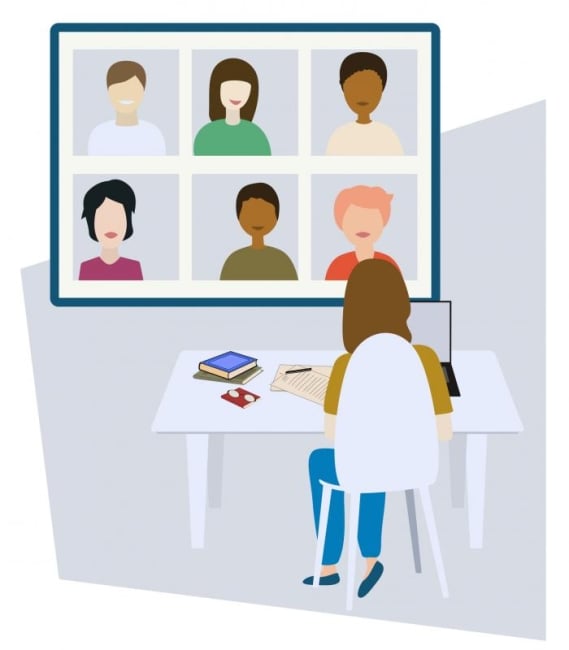You have /5 articles left.
Sign up for a free account or log in.

Nvard Akopyan/Istock via Getty Images
In a recent survey of more than 3,000 undergraduates taking courses online during the COVID-19 pandemic, Vikki Katz, associate professor in the School of Communication and Information at Rutgers University, along with her team of collaborators, found students were unhappy doing large-scale group projects. Students in the study found such projects online so frustrating that Katz and her colleagues recommended, “Group projects: just don’t do it.”
Katz and her colleagues emphasize that collaborative projects are important. They advocate assigning short-term group projects, managing them with care and making them low stakes. Since students now are contending with such things as illness and even death, unreliable bandwidth, and inadequate work and study environments, it is unfair to burden them with interdependence. They suggest that it is particularly difficult online to manage students who fall away, “ghost” the class for a period of time or fail to contribute, leaving their peers to shoulder the responsibilities for the group. Katz writes, “It serves neither you nor students to spend the semester managing group work dynamics that increase students’ anxiety instead of building community.”
While many of those suggestions are helpful, we would like to push back at the notion that managing group dynamics doesn’t serve students. It is complicated -- almost too complicated. However, guiding students in effective collaboration is one of the best ways to mentor them in this crisis.
We recognize that every instructor now is, like ourselves, facing the fraught and stressful conditions our students face -- and so is everyone else outside academe who is lucky enough to still have the kind of job that can be done remotely. As we write this piece “together” using collaborative writing tools (mostly email and Google Docs) and conferring by Zoom, one of us (Cathy) in Manhattan and the other (Christina) in Brooklyn, we each are hearing our partners in adjacent rooms, also on group video calls. One partner works in finance, the other in publishing. Both are on Zoom constantly, doing exactly the kind of work the students object to: group projects, under harrowing conditions, with stressed-out colleagues, 24-7.
As difficult as it is, now is exactly the time to be helping students learn how to collaborate online. Ditching group projects now, as the world increasingly depends on them, does not prepare our students for life beyond college.
We suggest, instead, that we need to show students why collaboration is important. In most workplace settings, collaboration is necessary so that we can succeed at tasks that no one person could begin to manage alone. Collaboration online is difficult yet essential. That’s the message we need to send students early and often, at the beginning of a semester, at the beginning of every class. We also need to reassure students that, as instructors, we have taken on the responsibility of ensuring that the process is equitable and each member of the group will be held accountable for completing work.
Key Recommendations for Course Collaborations
To that end, we offer the following tips for managing online course collaborations. (NB: These also work face-to-face.) Like all participatory, equitable, active learning, the goal of successful collaboration is to help students achieve a sense of agency, even within the strict parameters of a group project.
No. 1: Structure group projects around real-world problems. Not surprisingly, ample educational technology research across many fields shows that students have more positive learning outcomes when they tackle meaningful projects with actual consequences. As Stanford University professor emerita Andrea Lunsford and her team of researchers have found, students’ writing improves when they write to communicate beyond the classroom and not simply to the professor for a grade.
We suggest instructors take advantage of the online experience and the complexity of the current crisis. Many are doing this already through service learning. The faculty of the College of Arts and Sciences and the Sawyer Business School at Suffolk University offer examples of digital service learning that connect students to others through meaningful interactions such as developing a social media strategy for a community action group, designing marketing materials for a local nonprofit and gathering data for a community grant application.
No. 2: Create an equitable distribution of labor and assure students that you, not they, are responsible for this aspect of the collaboration. One key difference between student online collaborative projects and those in the workplace is accountability. In a class, too often the most dutiful students are so worried that an irresponsible classmate will bring down their grade that they often jump in and assume the supervisor role. That’s unfair to everyone in different ways.
Supplementing students’ group meetings with one-on-one meetings with you allows you to ask, “How is group work going? Have you heard from all your peers this week?” You can offer to nudge a missing student, for example, with an email. To tame your own scheduling, give students a spreadsheet, Calendly or another way to set up time for one-on-one meetings with you.
No. 3: Create “pods” large enough to guard against ghosting. We suggest a minimum of three people per group -- that way if one student doesn’t hold up their end, the rest of the group can continue moving forward. You might mentor students in these groups by holding office hours with the whole pod. This would help you save some time and labor, and you still can offer students one-on-one meetings with you to supplement pod office hours.
No. 4: Get rid of competition for grades within the group. We recommend contract grading for group projects. Assign each member of the project team a role, specific tasks and deadlines, and promise all the same final grade if they accomplish all they were assigned on deadline. Again, this mirrors contracts in the world beyond school.
No. 5: Assign prework. Increase student engagement by asking students to create their own job descriptions. We like to jump-start this by posting lists of jobs that might be pertinent to group work: e.g., project management, graphic designer, researcher, lead writer, copy editor, proofreader, web manager, community networker. We invite students to use these or add their own. Then, synchronously, during class time, we design a low-stakes activity: “In 90 seconds, jot down your top three ideal jobs/roles on this project, skills you feel confident delivering to the project and your peers.” Have students submit this information to you, with their names and availability to meet outside class, so you can better organize teams.
No. 6: Provide a clearly defined project timeline and checkpoints that help students move from one phase to the next. We suggest a number of intermediate deadlines, with clear deliverables for each group member at each milestone. Begin synchronous (in-class) group work with check-in time, where students share tasks completed and next steps. Encourage students to celebrate their successes and to help one another identify what needs to be done next.
No. 7: Be forgiving and adaptable. Both you and your students may need to revise the scope, the timeline and the responsibilities as the project unfolds. Build that flexibility in from the very beginning. In the world beyond college, not every contract is fulfilled, not every project is successful and, as we see in every homeowner reality TV renovation show, surprises come up and the scope of work changes accordingly. Being able to survey a situation and adapt realistically to it is another important skill in college, work and life. A key component of active, participatory, radical pedagogy is learning that everything we do is part of a process and that failure is not a state but an iteration of our learning on the way to greater success in the future.
No. 8: Put that achievement on a résumé! Once your class has completed this tremendous feat, show students how to put their accomplishment on a résumé. Literally. Have students search “workplace collaboration” online to see how many articles, books and management training opportunities exist for improving skills in this area. Job recruiters insist the ability to work well with others is a key skill they seek in new hires. If students succeed in their online collaborative projects, help them describe that success. They have earned it -- and so have you.




